《化工热力学》课程教学课件(英文讲稿)纯流体性质 Volumetric Properties of Pure Fluids
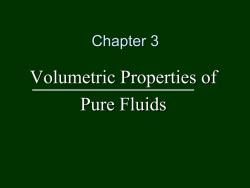
Chapter 3 Volumetric Properties of Pure Fluids
Chapter 3 Chapter 3 Volumetric Properties of Volumetric Properties of Pure Fluids Pure Fluids
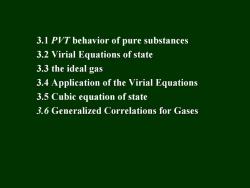
3.1 PIT behavior of pure substances 3.2 Virial Equations of state 3.3 the ideal gas 3.4 Application of the Virial Equations 3.5 Cubic equation of state 3.6 Generalized Correlations for Gases
3.1 PVT behavior of pure substances 3.2 Virial Equations of state Virial Equations of state 3.3 the ideal gas 3.3 the ideal gas 3.4 Application of the Virial Equations 3.4 Application of the Virial Equations 3.5 Cubic equation of state 3.5 3.6 Generalized Correlations for Gases Generalized Correlations for Gases
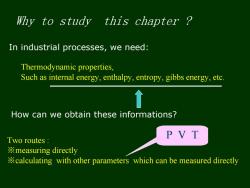
Why to study this chapter In industrial processes,we need: Thermodynamic properties, Such as internal energy,enthalpy,entropy,gibbs energy,etc How can we obtain these informations? PVT Two routes: ※measuring directly Xcalculating with other parameters which can be measured directly
Why to study this chapter ? In industrial processes, we need: Thermodynamic properties, Such as internal energy, enthalpy, entropy, gibbs energy, etc. How can we obtain these informations? Two routes : ※measuring directly ※calculating with other parameters which can be measured directly P V T
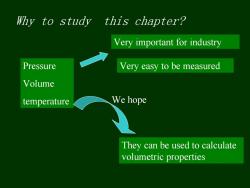
Why to study this chapter? Very important for industry Pressure Very easy to be measured Volume temperature We hope They can be used to calculate volumetric properties
Pressure Volume temperature They can be used to calculate volumetric properties Very easy to be measured Very important for industry We hope Why to study this chapter?
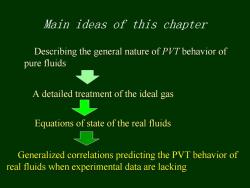
Main ideas of this chapter Describing the general nature of PIT behavior of pure fluids A detailed treatment of the ideal gas Equations of state of the real fluids Generalized correlations predicting the PVT behavior of real fluids when experimental data are lacking
Main ideas of this chapter Describing the general nature of Describing the general nature of PVT behavior of behavior of pure fluids pure fluids A detailed treatment of the ideal gas A detailed treatment of the ideal gas Generalized correlations predicting the PVT behavior of Generalized correlations predicting the PVT behavior of real fluids when experimental data are lacking real fluids when experimental data are lacking Equations of state of the real fluids Equations of state of the real fluids
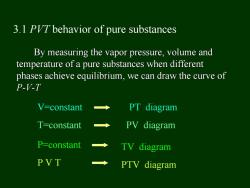
3.1 PIT behavior of pure substances By measuring the vapor pressure,volume and temperature of a pure substances when different phases achieve equilibrium,we can draw the curve of P-V-T V=constant PT diagram T=constant PV diagram P=constant TV diagram PVT PTV diagram
3.1 PVT behavior of pure substances By measuring the vapor pressure, volume and By measuring the vapor pressure, volume and temperature of a pure substances when different temperature of a pure substances when different phases achieve equilibrium, we can draw the curve of phases achieve equilibrium, we can draw the curve of P-V-T V=constant PT diagram T=constant PV diagram P=constant TV diagram P V T PTV diagram
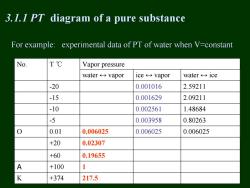
3.1.I PT diagram of a pure substance For example:experimental data of PT of water when V=constant No. T℃ Vapor pressure water←→vapor ice←→vapor water←→ice -20 0.001016 2.59211 -15 0.001629 2.09211 -10 0.002561 1.48684 -5 0.003958 0.80263 0.01 0.006025 0.006025 0.006025 +20 0.02307 +60 0.19655 A +100 1 K +374 217.5
For example: experimental data of PT of water when V=constant For example: experimental data of PT of water when V=constant No. T ℃ Vapor pressure water ↔ vapor ice ↔ vapor water ↔ ice -20 0.001016 2.59211 -15 0.001629 2.09211 -10 0.002561 1.48684 -5 0.003958 0.80263 O 0.01 0.006025 0.006025 0.006025 +20 0.02307 +60 0.19655 A +100 1 K +374 217.5 3.1.1 PT 3.1.1 PT diagram diagram of a pure substance of a pure substance
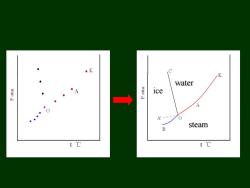
。K C K water une d A ice → 。 A'- 0 steam B t℃ t℃
water steam ice
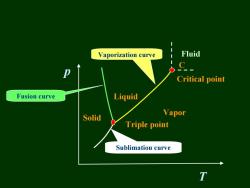
Vaporization curve Fluid Critical point Fusion curve Liquid Solid Vapor Triple point Sublimation curve
p T Liquid Vapor Solid Triple point Critical point Sublimation curve Fusion curve Vaporization curve Fluid C
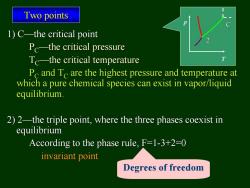
Two points 1)C-the critical point Pc-the critical pressure Tc-the critical temperature Pc and Tc are the highest pressure and temperature at which a pure chemical species can exist in vapor/liquid equilibrium. 2)2-the triple point,where the three phases coexist in equilibrium According to the phase rule,F=1-3+2=0 invariant point Degrees of freedom
1) C—the critical point the critical point PC—the critical pressure the critical pressure TC—the critical temperature the critical temperature PC and TC are the highest pressure and temperature at are the highest pressure and temperature at which a pure chemical species which a pure chemical species can exist in vapor/liquid can exist in vapor/liquid equilibrium. equilibrium. 2) 2—the triple point, where the three phases coexist in the triple point, where the three phases coexist in equilibrium equilibrium According to the phase rule, F=1 According to the phase rule, F=1-3+2=0 3+2=0 invariant point invariant point Two points Two points p T 2 C Degrees of freedom
按次数下载不扣除下载券;
注册用户24小时内重复下载只扣除一次;
顺序:VIP每日次数-->可用次数-->下载券;
- 《化工热力学》课程教学资源(作业习题)第8章 化学反应平衡(含答案).doc
- 《化工热力学》课程教学资源(作业习题)第5章 非均相体系热力学性质计算(无答案).doc
- 《化工热力学》课程教学资源(作业习题)第4章 非均相封闭体系热力学(选择题带答案).doc
- 《化工热力学》课程教学资源(作业习题)第2章 流体的P-V-T关系(含答案).doc
- 《化工热力学》课程教学资源(作业习题)第1章 绪言(无答案).doc
- 《化工热力学》课程授课教案(讲义)Chapter 13 Chemical-Reaction Equilibria.doc
- 《化工热力学》课程授课教案(讲义)Chapter 12 Solution Thermodynamics:Application.doc
- 《化工热力学》课程授课教案(讲义)Chapter 11 Solution thermodynamics - Theory.doc
- 《化工热力学》课程授课教案(讲义)Chapter 9 Refrigeration and Liquefaction.doc
- 《化工热力学》课程授课教案(讲义)Chapter 8 Production of Power from Heat.doc
- 《化工热力学》课程授课教案(讲义)Chapter 7 Application of Thermodynamics to Flow Processes.doc
- 《化工热力学》课程授课教案(讲义)Chapter 6 Thermodynamic properties of fluids.doc
- 《化工热力学》课程授课教案(讲义)Chapter 5 The Second Law of Thermodynamics.doc
- 《化工热力学》课程授课教案(讲义)Chapter 3 Volumetric Properties of Pure Fluids.doc
- 《化工热力学》课程授课教案(讲义)Chapter 2 The First Law and Other Basic Concepts.doc
- 《化工热力学》课程教学大纲 Thermodynamics of chemical engineering(新疆大学:黄雪莉).doc
- 海南大学:《精细化学品与工艺学》课程授课教案(讲义,共十章,负责人:刘钟馨、韩秀萍).docx
- 海南大学:《精细化学品与工艺学》课程教学课件(PPT讲稿)食品添加剂 Food additives.ppt
- 海南大学:《精细化学品与工艺学》课程教学课件(PPT讲稿)涂料(醇酸树脂涂料、丙烯酸树脂涂料).pptx
- 海南大学:《精细化学品与工艺学》课程教学课件(PPT讲稿)表面活性剂 surfactants.ppt
- 《化工热力学》课程教学课件(英文讲稿)流体热力学性质 Thermodynamic properties of fluids.pdf
- 《化工热力学》课程教学课件(英文讲稿)热动力 Production of Power from Heat.pdf
- 《化工热力学》课程教学课件(英文讲稿)溶液热力学原理 Solution thermodynamics:Theory.pdf
- 《化工热力学》课程教学课件(英文讲稿)热功转换及可用能.pdf
- 《化工热力学》课程教学课件(PPT讲稿)第一章 绪论 Chemical Engineering thermodynamics.ppt
- 《化工热力学》课程教学课件(PPT讲稿)第二章 流体的p-V-T关系.ppt
- 《化工热力学》课程教学课件(PPT讲稿)第五章 化工过程的能量分析.ppt
- 《化工热力学》课程教学课件(PPT讲稿)第七章 相平衡.ppt
- 《化工热力学》课程教学课件(PPT讲稿)第三章 流体的热力学性质.ppt
- 《化工热力学》课程教学课件(PPT讲稿)第六章 蒸汽动力循环与制冷循环.ppt
- 《化工热力学》课程教学课件(PPT讲稿)第十章 化学反应平衡.ppt
- 《化工热力学》课程教学课件(PPT讲稿)第四章 流体混合物的热力学性质.ppt
- 《化工原理》课程教学大纲 Principles of Chemical Engineering B.pdf
- 《化学反应工程》课程教学标准B.doc
- 山东理工大学:《化学反应工程》课教学大纲B.doc
- 《化工安全与环保》课程教学资源(课件讲稿)物质性质、物化原理与安全.pdf
- 《化学反应工程》课程教学资源(PPT课件)第3章 釜式及均相管式反应器.ppt
- 《化学反应工程》课程教学资源(PPT课件)第4章 反应器中的混合及对反应的影响.ppt
- 《化学反应工程》课程教学资源(PPT课件)第5章 固定床气-固相催化反应工程.ppt
- 《化学反应工程》课程教学资源(课件讲稿)第2章 气-固相催化反应本征及宏观动力学.pdf
